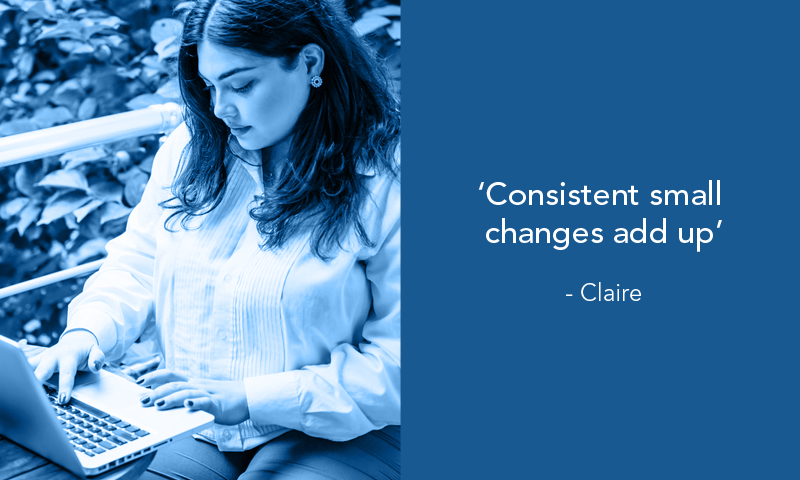Welcome back to week 6 of our 12 Week Weight Management Programme. Very well done for getting this far and keeping going. All of the changes you’re making will be having a positive impact on your weight and wellbeing.
Weekly check-in
How did you get on last week? Have you been successfully using the hunger scale?
If you would prefer you can print out our blank weekly journal (PDF, 42 KB) to fill in yourself.
Increasing your physical activity
We’ve talked each week about increasing your level of physical activity. Now that we’re halfway through the 12 weeks it’s time to consider your physical activity.
Current recommendations are that adults should be physically active every day, with different of types of physical activities. These should combine physical activities such as walking with strength activities like yoga, Pilates or sit ups.
Don’t worry at this point if you’re not at this level, our programme is about helping you towards meeting these recommendations and then keeping them going. If you’re unsure how physically active you are then an activity calculator can help you.
If you’ve increased your physical activity levels over the past 6 weeks, well done. Can you increase the time, increase the intensity or try different physical activities?

Trying new activities
If you haven’t yet started to do more physical activity, then this week consider what physical activity you could do? Go back to week 2 and read through the advice, particularly about thinking back to a time when you were doing physical activity you enjoy.
Think about the different types of activities there are and about increasing intensity.
Local activities
Is there a local group or club that you could join for example walking football or walking group? Is there a friend or family member you could be more physically active with such as meeting a friend for a dog walk or joining a class with a friend? Also think about using parks and open spaces for walking, playing with your family as a good way of increasing your physical activity.
If you have a physical disability then there is also advice and ideas to keeping active.
You can find local keeping active groups and clubs using our services directory.
Decreasing your inactive time
Inactive time is the amount of time you’re not being active, for example sitting watching TV or on computers. This is also called being sedentary. For those at work, it includes the time sitting at your desk. Inactive time negatively affects your health and isn’t helping you burn calories.
Even if you’re being physically active during the day you should consider how much time you’re being inactive and try to decrease it. For example, getting up and moving about at home or in your workplace every hour or so.
Energy balance
We have talked about energy balance a lot through the last 6 weeks. It can help you to get a good idea of the calorie content in food and drink compared to using up those calories through physical activity. The answers here are all based on averages and are only used as an example.
Have a look at the foods and how long you would need to do each activity to use up the calories in the food or drink.
| Food or drink | Typical Calories | Walking(moderate speed) | Swimming(freestyle slow) | Cycling(gentle speed) |
| Burger and chips | 660 | 2 hours 27 mins | 1 hour 9 mins | 1 hour 21 mins |
| Packet of crisps | 130 | 29 mins | 14 mins | 16 mins |
| Bar of chocolate | 255 | 57 mins | 27 mins | 31 mins |
| Apple | 80 | 18 mins | 8 mins | 10 mins |
| Can of cola with sugar | 139 | 31 mins | 15 mins | 17 mins |

Local NHS weight management services
In Scotland all NHS health services have local weight management services. Some of these will be delivered by local leisure providers and even some local football clubs.
This might be a good week for you to start exploring what’s available from the NHS in your local area.
Setting your goals
When setting your weekly goals you should:
- decide which day next week you will be coming back to this programme, this will be the day you can review your goals
- consider the areas for change we have discussed this week
- look at your lifestyle diary/journal/app/photos and choose areas where you feel you could make a small change over the next week
- ask yourself what you can do more of, what you can do less of and what would help you me make these changes
- add 1 or 2 new goals – we recommend 3 to 4 weekly changes goals are the most you should ever set yourself
If you don’t meet your goals every day, that’s ok. It’s important to keep returning to what you’ve written down. We’ll review them next week.
Your can use our goal-setting tool to record your goals for the week, or print out our blank weekly journal (PDF, 42KB) to fill in yourself.
For next week
During this week you should:
- consider which of your current behaviours you feel ready to change and set realistic goals for this week
- continue to monitor your goals by keeping your lifestyle diary or journal, app or take photos
- record your levels of physical activity
- try a new strengthening physical activity such as yoga, floor based excercises or water aerobics
Last updated:
18 May 2020
